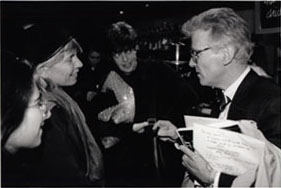Group Thinking
The Star Wars
Phenomenon
 There
are films that are like going to church, and films that are like going
to a football game. In one you are alone, communing with your spirit;
in the other, you're in a group, cheering and booing. Is it any surprise
that our group-identity culture favors group-think experiences? That our
soul-denying, soul-fearing society imagines life as a public event?
There
are films that are like going to church, and films that are like going
to a football game. In one you are alone, communing with your spirit;
in the other, you're in a group, cheering and booing. Is it any surprise
that our group-identity culture favors group-think experiences? That our
soul-denying, soul-fearing society imagines life as a public event?
The insides of experience disappear. It becomes skin deep. We become the newspapers' accounts of us. The shyness, secrecy, and mystery of identity are erased.
These films are America–where sociology has become the new ontology. The capitalist drama of doing shoves aside the spiritual drama of being. I fight and compete, therefore I am. Allegorical abstractions, generic identities, and flat-minded performances steamroll the butterfly flutterings of personal feeling. The bray of bigness, violence, and obviousness drowns out the still, small voice of the soul. Its vital demisemiquavers are slurred. We run away from ourselves. We get what we are....
–Excerpted from Ray Carney's "Group Thinking: The Lesson of Star Wars," The Christian Science Monitor, Friday May 14, 1999, p. 16.
* * *
Kane as Kitsch
 Melodramatic
mumbo-jumbo. Exuberant, gorgeous nonsense. Fun? Of course. A profound
work of art? Hardly.
Melodramatic
mumbo-jumbo. Exuberant, gorgeous nonsense. Fun? Of course. A profound
work of art? Hardly.
It takes more than bombastic rhetoric, gaudy visuals, and scenery-chewing performances to make a masterpiece.
Kane is an all-American triumph of style over substance. Welles is Kane–in a sense he couldn't have intended–substituting razzle-dazzle for truth and hoping no one notices the sleight of hand.
The movie is indistinguishable from the opera production within it: attempting to conceal the banality of its performances by wrapping them in a thousand layers of acoustic and visual processing.
Critics obviously enjoy being told what to think or they'd never sit still for the hammy acting, cartoon characterizations, tendentious photography, editorializing blockings, and absurdly grandiose (and annoyingly insistent) metaphors. This means this. That means that. Get it? Got it!
Everything's shifted one notch to the side of reality. It's all a metaphor. Wow. What an original idea. Don't you just love it when things are big and bloated with meaning? That's what art does. A big house symbolizes loneliness. A sled, the uprooting of your youth. That sure is profound. I sure learned a lot from that! Heavy. Pass the J, dude.
When will film studies grow up? Even Jedediah Leland, the opera reviewer in the film, knew better than to be taken in by Salaambo's empty reverberations.
My personal nominee (along with Psycho, 2001, The Godfather, and Chinatown) for one of the ten most over-rated American films of all time.
–Excerpted from Ray Carney's, "Citizen Kane on its Fiftieth Anniversary: The Greatest Movie Ever Made?" The Christian Science Monitor, Tuesday, April 30, 1991.
* * *
Schindler's List
Or: Feeling Good about Feeling Bad
Schindler's List simply rehashes Spielberg's inflatable, one-size-fits-all myth about how a clever, resourceful character can outsmart a system. Is that what the meaning of the Holocaust boils down to–Indiana Schindler versus the Gestapo of Doom? Schindler is a Hollywood producer's self-congratulatory fantasy of how giving people a chance to work for you is doing them a big favor. What real courage did it take to make this movie? What new understanding of the Holocaust did it reveal? Spielberg could have made a really courageous film if he had dared to make a movie sympathetic to the SS, a movie that deeply, compassionately entered into the German point of view in order to reveal how regular people with wives and children could be drawn into committing or silently consenting to such horrors. How about a movie that showed that, at least potentially, we are them? A film that didn't locate the bad guys in an emotional and historical galaxy far away? Of course, Spielberg could never make that film even if he tried to, because it would require too much insight on his part. And if he did make it, it would not get Academy Awards. It would require viewers to think. And thinking, real thinking, is always dangerous. Audiences might be forced to confront truths that they would rather avoid. Instead of affording them another opportunity to revel in their own virtue, they just might be made to squirm a little.
–Excerpted from Ray Carney's, "Pulp Affliction: The Sorry State of Contemporary Film," The Baffler no. 8, May 1996.
* * *
Disneywood
Watching the Terminator movies is a lot like watching a football game. Watching Malcolm X is a lot like reading one of those simple-minded children's biographies they assign you in middle school. Watching Top Gun is a lot like playing a video game. But what does that prove? It proves that schlock movie experiences resemble schlock non-movie experiences. The confusion arises when we try to dignify either set of experiences by giving them the fancy title of "popular art" or by calling them expressions of "mass culture" so that we can include them in a course. Why not just call them mindless, trashy vegging-out?
The advantage is not only a terminological clarity. If we called these films by the right names we wouldn't make the conceptual error of freighting them with portentous sociological or psychological meanings either. The Terminator, Forrest Gump, Top Gun, or ET are not profound expressions of our society or its beliefs. They are not tap roots into our psyches. And one obvious reason they are not, is that they do not truly emanate from ordinary people the way primitive paintings or quilts or hope chests do. These movies are planned and funded by big corporations to make money. They are conscious and deliberate corporate contrivances to take seven dollars and fifty cents out of as many pockets as possible. They are not anonymous expressions of the voice of the people. They are business deals put together to make money by a group of millionaire California producers, agents, and venture capitalists. In that sense, Spielberg's movies far are more "elitist"–less an expression of the concerns of the ordinary person–than any movie Jon Jost ever made.
–Excepted from "A Conversation with Ray Carney–Part 2" MovieMaker no. 14 July/August 1995.
* * *
The Titanic Fallacy of Romantic Purity and Intensity
 Most
Hollywood movies ultimately boil down to making the viewer feel good by
flattering him. Every girl watching Titanic is allowed to see herself
as Kate Winslett; every boy as Leonardo DiCaprio. Who wouldn't want to
think of themselves as being this noble, this glamorous, this heroic–this
capable of love, self-sacrifice, or suffering? It's a big lie of course.
Life isn't like this and no one's emotions are this pure and uncompromised.
We're much more mixed, troubled, uncertain of ourselves. Real love isn't
this self-sacrificing and unconditioned. It is mixed with unloving feelings
like selfishness and pettiness and the desire for appreciation. Real suffering,
sacrifices, and loss is not unconditioned and absolute, but laced with
anger and resentment and self-justification. Real virtue is often critical
and intolerant of others' deficiencies. And we lapse from virtue as often
as we adhere to it. We lie to ourselves constantly with self-justifying
stories about how much harder we work, how much more we deserve
success than others do. One might say that the very appeal of Hollywood
film is proof of our emotional imperfection. The only reason we crave
these movies is because we are addicted to glamorizing our emotional states,
to deluding ourselves, to telling ourselves comforting stories about ourselves.
Their repressions are proof of our insecurity and desperation for flattery.
Their purity is evidence of the impurity they deny.
Most
Hollywood movies ultimately boil down to making the viewer feel good by
flattering him. Every girl watching Titanic is allowed to see herself
as Kate Winslett; every boy as Leonardo DiCaprio. Who wouldn't want to
think of themselves as being this noble, this glamorous, this heroic–this
capable of love, self-sacrifice, or suffering? It's a big lie of course.
Life isn't like this and no one's emotions are this pure and uncompromised.
We're much more mixed, troubled, uncertain of ourselves. Real love isn't
this self-sacrificing and unconditioned. It is mixed with unloving feelings
like selfishness and pettiness and the desire for appreciation. Real suffering,
sacrifices, and loss is not unconditioned and absolute, but laced with
anger and resentment and self-justification. Real virtue is often critical
and intolerant of others' deficiencies. And we lapse from virtue as often
as we adhere to it. We lie to ourselves constantly with self-justifying
stories about how much harder we work, how much more we deserve
success than others do. One might say that the very appeal of Hollywood
film is proof of our emotional imperfection. The only reason we crave
these movies is because we are addicted to glamorizing our emotional states,
to deluding ourselves, to telling ourselves comforting stories about ourselves.
Their repressions are proof of our insecurity and desperation for flattery.
Their purity is evidence of the impurity they deny.
–Excerpted from Ray Carney, "The Path of the Artist, Part III," MovieMaker, Issue 38 (Spring 2000).
* * *
Flattery
There are a million other ways to flatter the viewer. Hitchcock flatters his by giving them the satisfaction of solving a puzzle. They can match wits with him and feel clever when they figure something out. Most independent films play the same flattery game in other ways. Woody Allen, David Lynch, Quentin Tarantino, John Dahl, and Curtis Hanson allow viewers to feel smart because they get the in-jokes, the hip allusions, the ironic winks and nods.
Flattery is a terrible basis for a work of art. How do you feel about someone who flatters you in life? Isn't it a sign that they think you are stupid? That they have contempt for you? Why would you want to do it to people watching your movie?
–Excerpted from Ray Carney, "The Path of the Artist," Part III, MovieMaker, Issue 38 (Spring 2000).
* * *
The Easy Pleasures of Puzzle-Solving
The only reason problem-solving, goal-driven, jigsaw-puzzle pictures are so popular is because they are so infantile. It takes no knowledge of life, no sensitivity to emotions, to understand them. Film teachers love films like The Godfather, 2001, Blade Runner, or Pulp Fiction because they can be explained to a Freshman film class with ten catch phrases in fifty minutes. They require no understanding of people, no cultural awareness or historical knowledge. Make a film which you have to know something about life–about the difference between men and women, about what it is to be a parent or a child, about our states of emotional confusion–to appreciate. Make a film that you couldn't have understood when you were in high school or college. Make a film a professor can't reduce to metaphors and symbols.
The problem is the lessons in these movies are too cheap. They don't threaten any of our old ways of knowing. They are weightless emotional experiences. Their game playing defies gravity. There is nothing serious at stake. The emotions are superficial. As when we come out of the haunted house in a carnival, we blink into the light unchanged by the experience, forgetting it almost immediately. Real knowledge is not free; it must be paid for by giving up old understandings dear to us. And that always hurts, at least a little. As it said in my high school locker room: no pain no gain.
–Excerpted from Ray Carney, "The Path of the Artist," Part III, MovieMaker, Issue 38 (Spring 2000).
* * *
"Lite" Mysteries
Life is mysterious, but its mysteries are entirely different from the mystifications in L.A. Confidential, Blood Simple, Blue Velvet, or Psycho. Their mysteries are shallow. They can be cleared up with a few words of explanation. Their puzzlements are trivial–matters of fact and event, of who did what to whom. Make a film about real mysteries, mysteries that don't involve facts but feelings–like the mystery of who we are, the mystery of why we do hurtful things to ourselves and others, the mystery of why the effects of our actions can be so different from our intentions, the mystery of why we can never see ourselves as others see us.
–Excerpted from Ray Carney, "The Path of the Artist," Part III, MovieMaker, Issue 38 (Spring 2000).
Desert Island Movies
 You
guessed it. I'll be the only desert dweller not to show up for those reduced
admission Citizen Kane nights. As far as I am concerned, America's
most over-rated movie is style a mile high and truth an inch deep. It's
pure adolescent bosh: How lonely I am. Oh, me. Oh, my. Feel sorry for
me. It's what's wrong with our culture. It captivates the critics because
it's presented as a jigsaw puzzle they can feel clever about putting together.
And because it has all those fancy visual and acoustic effects. Wow. If
that was what art was about, Michael Jackson's Superbowl Half-time
Show would rank with Rembrandt's pencil sketches.
You
guessed it. I'll be the only desert dweller not to show up for those reduced
admission Citizen Kane nights. As far as I am concerned, America's
most over-rated movie is style a mile high and truth an inch deep. It's
pure adolescent bosh: How lonely I am. Oh, me. Oh, my. Feel sorry for
me. It's what's wrong with our culture. It captivates the critics because
it's presented as a jigsaw puzzle they can feel clever about putting together.
And because it has all those fancy visual and acoustic effects. Wow. If
that was what art was about, Michael Jackson's Superbowl Half-time
Show would rank with Rembrandt's pencil sketches.
Nor do I have any desire to round up the other usual suspects for my desert island jaunt. The symbols in 2001 clang so loud they make my ears ring. I leave Vertigo, Rear Window, and North by Northwest to high schoolers whose idea of art is tricks and games and button-pushing.
If only one set of film cans is allowed to wash ashore on my desert island, let it be a film with real emotion (not that fake stuff) and true perceptiveness about who and what we are. Maybe Mark Rappaport's The Scenic Route or Local Color –guided tours of our dreams and delusions. Or make it Robert Kramer's Milestones–an epic voyage through the vast landscape of lost American connections in search of links to the past and future. Or John Cassavetes' Faces–a deep study of the difference between men and women, the emotional cages both sexes imprison ourselves within, and the business ethics of our sick culture. Those are movies you can live with, and live into, movies you have to earn the right to deserve. They aren't obvious. They don't wear out. They don't provide instant gratification thrills and chills. Their mysteries stay mysterious because they are not based on a gimmick. They are not flashy and jazzy–but tell challenging, disturbing truths.
–Excerpted from Ray Carney, "Desert Island Movies," MovieMaker (February 1997).
For a positive view of the function of art, see the Independent Vision section.
To read more about fads and fashions in criticism, click on "Multicultural Unawareness" and "The Functions of Criticism" in the Carney on Culture section, the essays "Sargent and Criticism" and "Eakins and Criticism" in the Paintings section, "Day of Wrath: A Parable for Critics" in the Carl Dreyer section, "Capra and Criticism" in the Frank Capra section, all of the other pieces in this section, and the essays "Skepticism and Faith," Irony and Truth," "Looking without Seeing," and other pieces in the Academic Animadversions section.
This page only contains excerpts and selected passages from Ray Carney's writing. To obtain the complete text of this piece as well as the complet texts of many pieces that are not included on the web site, click here.